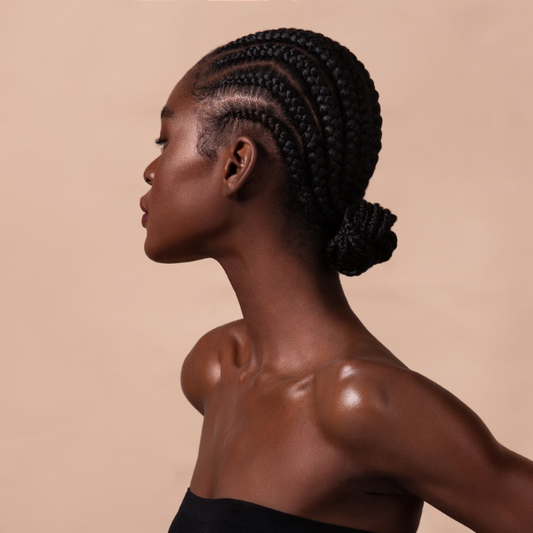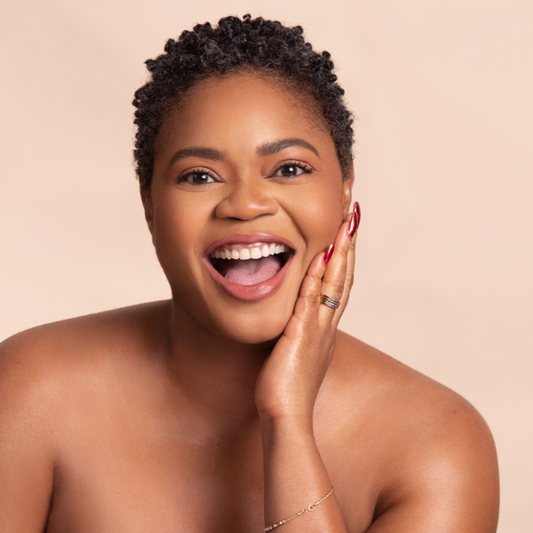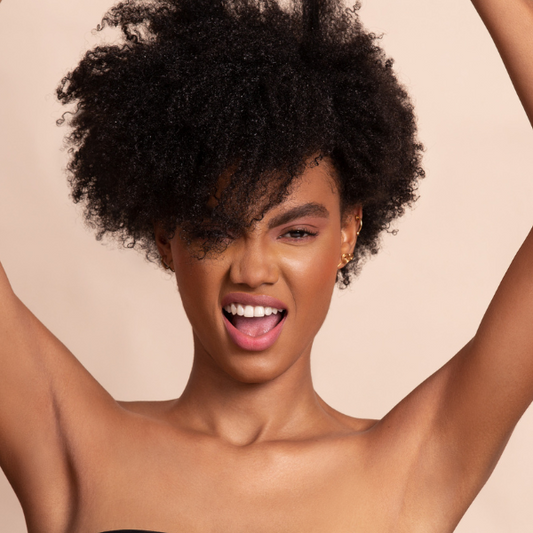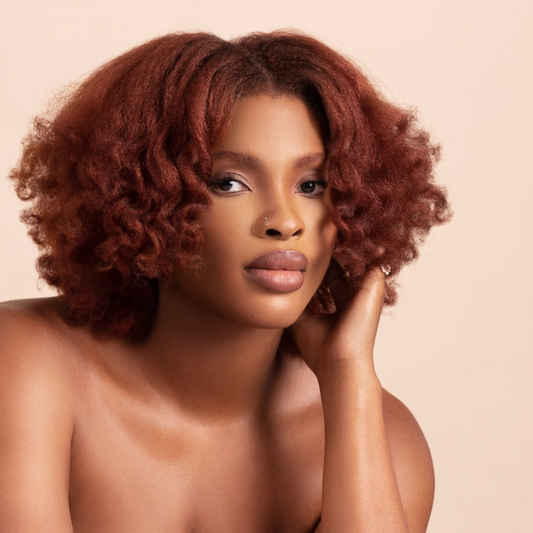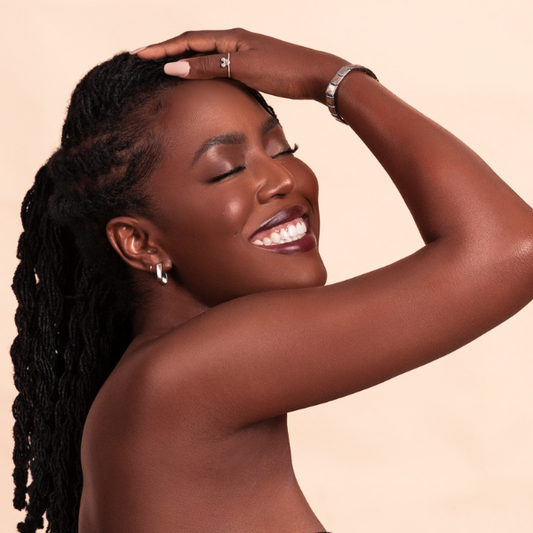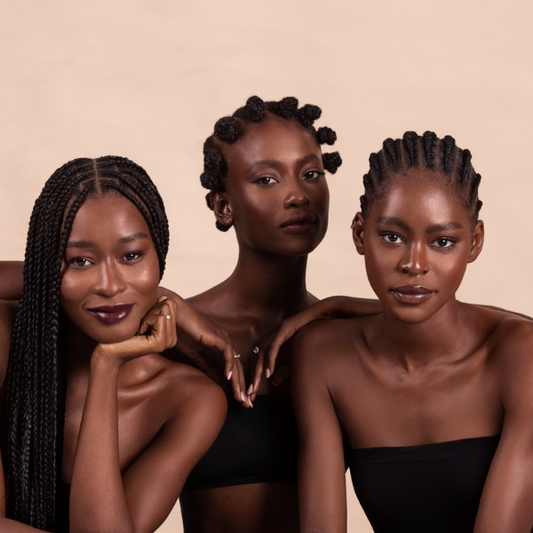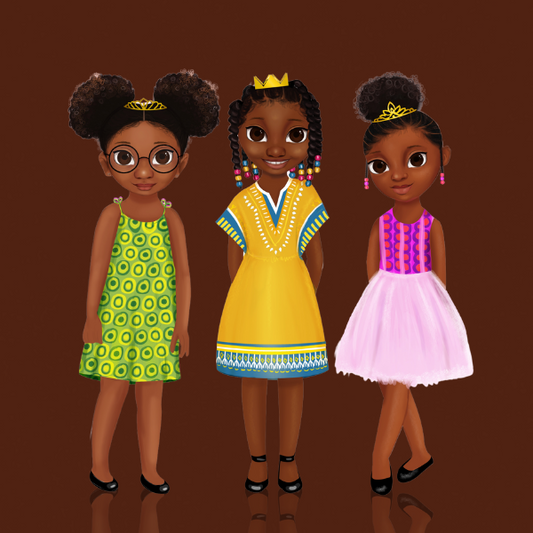Hair Density
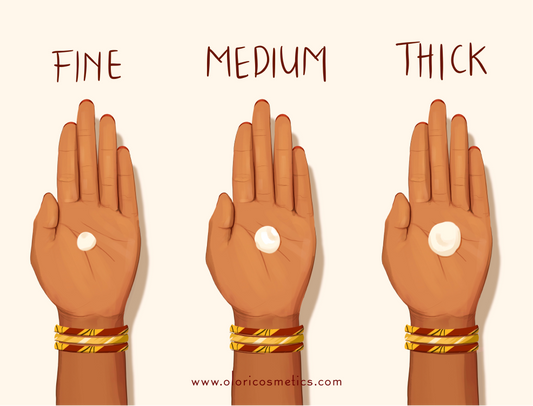
Density is the amount of hair on your head and how close they are to each other.
Density is often confused with thickness; the difference is, density is how full your entire head of hair is altogether, whereas thickness is measured by how full each individual strand of hair is.
The density of your hair does not affect your hair type, but it’s an important characteristic to understand as it will determine how much product you’ll need to use to ensure all your hair is covered. High-density hair needs more product, while low-density needs less. It’ll also affect what hairstyles suit you best.
The OLORI team uses the following foolproof methods to test for hair density:
NATURALLY CURLY HAIR PARTING TEST
Leave your hair out in its natural state. If it’s tied up or weighed down in any way, let it loose. Don’t comb it in any direction and don’t attempt to tame it; just leave it be.
Take a close look at your hairline. If you can clearly see your scalp without having to touch it, your hair is most likely low-density.
If you can somewhat decipher patches of scalp, your hair is probably medium-density.
If you can’t see your scalp whatsoever, you probably have high-density hair.
PONYTAIL TEST
Pull your hair into a ponytail with one hand
If your hair forms a tiny ponytail in your hand, you probably have low-density hair
Curl Pattern
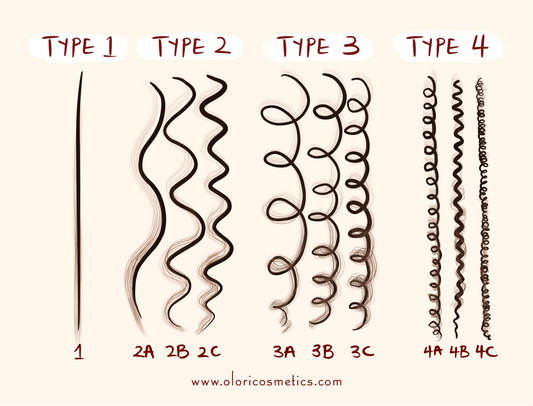
There’s a number of curl pattern systems, but the most widely recognised one is the Andre Walker Hair Typing System. Ranging from 1A to 4C, this system classifies hair depending on the natural degree of curl in its strands; type 1 encompasses straight hair, type 2 is for wavy, type 3 is for curly and type 4 is for coily hair. The suffixes A, B and C describe the degree of coil variation with ‘C’ hair being the most coily type within each category.
An easy way to identify your curl pattern is to compare your hair to some examples of people with different hair types.
Another method is to take a single strand of your hair and lay it down on a white surface so you can see it clearly (e.g. a piece of paper).
Type 1 hair is generally pretty straight, type 2 hair tends to take on a wavy ‘S’ curl, type 3 hair is loopier and can be described as a ‘C’ curl. Finally, type 4 hair is identified by its distinct coils and strands whose direction changes sharply (as opposed to changing directions in a loop like type 3 hair). As a result, type 4 hair is sometimes described as a ‘Z’ curl.
Your curl pattern is a classification of how far away your hair is from straight. Your curl pattern is often seen as synonymous to “hair type”, but in reality, so many more characteristics contribute to the “type” of hair you have.
Your curl pattern isn’t as significant as the other 2 key things when it comes to understanding your hair and knowing what it needs. Think of your hair as a book. Your curl pattern is like the art on a book cover and the other 2 things (hair porosity and treatments) are like the blurb. The curl pattern/cover is an aesthetic manifestation of the contents of your hair, but the blurb will ultimately tell you a lot more about what to expect from the book.
However, your curl pattern directly affects how your hair looks, so it’s an important aspect to learn about in order to fully understand the appearance of your hair.
A deep dive into Type 4 hair
Type 4A:
4A strands have the most defined coils within the type 4 category. The strands might be slightly loopier, and appear more curly than coily and the curl pattern remains defined regardless of whether your hair is wet or not.
Type 4B:
4B hair appears quite fluffy when dry. It has a fairly defined ‘Z’ curl pattern when dry, but these coils are most visible when the hair is wet.
Type 4C:
You can tell that your hair is type 4C if it has no clearly defined curl pattern when dry. When wet, however, you might be able to observe extremely tight coils and shrinkage of up to 70%. Shrinkage means how much your hair “shrinks” when wet. Type 4C hair could be shoulder length when dry, but look two inches long when wet.
Hair Porosity
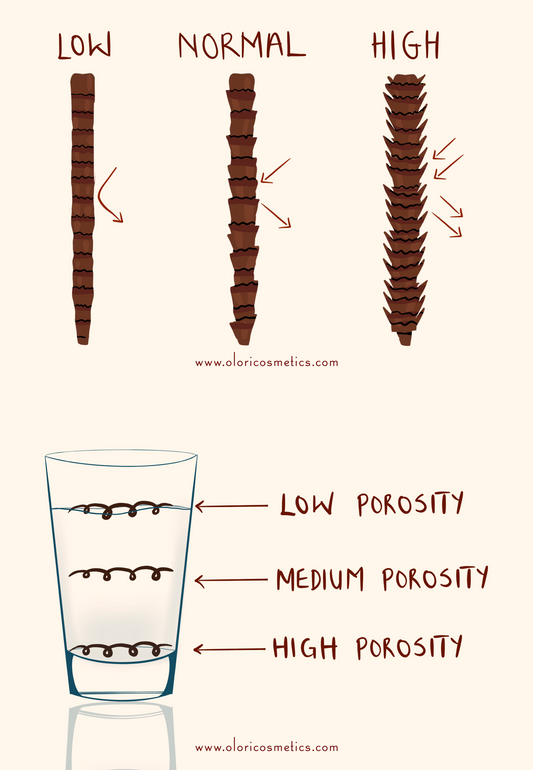
Porosity is how much moisture your hair lets in and out.
Having high porosity hair means it may be easier for you to moisturize your hair, however, this moisture can be lost just as easily as it’s gained. You’ll need to take extra care to lock your moisture in with a sealant such as an oil or gel.
Low porosity hair has a tough outer layer; it doesn’t let anything in or out. You’ll have to put extra work in to make sure any moisturizing products you’re applying are actually penetrating the cuticle and not just sitting on top. Go for protein-free products and warm up your conditioners before applying to prevent build-up. You’ll thank us later; once your hair is effectively moisturized, that moisture is pretty much stuck in there.
Normal porosity is right between the other two; it lets a good amount of moisture in without letting too much out.
Your hair porosity is genetic, but it increases with damage: this means that dyeing, relaxing or straightening your hair can contribute to higher porosity hair over time.
The OLORI team uses the following foolproof methods to test for porosity:
Float Test:
- Grab a couple of strands of your hair from a hairbrush or comb and drop them into a bowl of water.
- Give them a minute or two to settle
- If most of your strands sink to the bottom of the bowl, you have high porosity hair
- If they float, you have low porosity hair
You could also end up with something in between
- If they all stay suspended in the middle of the water you most likely have normal porosity hair
If half float and the other half sink, you probably have mixed porosity hair. This state of porosity is most observed with transitioning hair. Check our Transitioning Guide for more specific advice
Mist Test:
- Fill a spray bottle with some water and nothing else.
- Make sure your hair is totally dry and product-free. This method works best on freshly washed, dry hair.
- Spray some water on your hair and observe closely for over a minute or so.
- If the water beads up on the surface of your hair, you have low porosity hair
- If the water is absorbed and your hair gets wet, you have high porosity hair
Moisturizing for Different Porosities
The LOC method is lauded as the most effective way of properly moisturizing Afro-textured hair. It’s pretty simple, LOC stands for Liquid, Oil and Cream, and it can be used on hair of all curl patterns, including relaxed hair! The method goes as follows: hydrate your hair with a water-based product (Liquid), lock in that hydration by moisturizing with an oil-based product (Oil) and seal the hair cuticle with a cream product (Cream).
LOC is the standard form, but there’s a couple of variations on this moisturisation method:
- LCO: This stands for Liquid, Cream and Oil. It’s the exact same steps as in the LOC method, just in a different order. This method is recommended for low porosity hair as the use of Cream before the Oil increases the amount of moisturisation being put into one’s hair before sealing the cuticle. Low porosity hair types are more difficult to get moisture into, but manage to keep it tightly locked in, so the LCO method puts the emphasis on hydration and moisturisation as opposed to sealing it in.
- LO: This is simply Liquid and Oil. It’s recommended for medium porosity hair, as this hair type absorbs and releases at an intermediate rate, so it doesn’t need too much moisturisation or too much locking in. Just a little of each is perfect.
The standard LOC method is highly recommended for high porosity hair as both the O and the C steps to the method contribute to barricading the moisture in.
Achieve this with the following OLORI products:
- For the L step: DamageBeGone 3-in-1 Multi Conditioner
- For the C step: DamageBeGone 3-in-1 Multi Conditioner
- For the O step: DamageBeGone Happy Hair Butter
Relaxed Hair
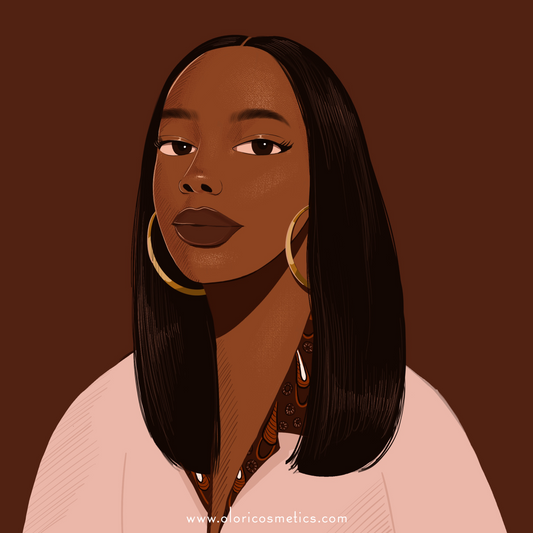
Relaxed hair is Afro-textured hair which has been chemically treated with a relaxer, regardless of the amount of relaxer which has been used. Relaxed hair is falsely advertised as being hair which has been chemically straightened, however, the term also encompasses texturised hair: hair which has had its curls chemically loosened.
Relaxed hair tends to fall between the 1A and 3C range, so it can be straight, wavy, curly or even a little coily. Relaxed hair appears a lot less dense than natural hair as the relaxing process straightens one’s hair out, thus reducing the amount of space it takes up. The chemicals used in relaxers can be harsh, so they can occasionally result in minor hair loss, which also contributes to relaxed hair appearing less dense.
Porosity tends to increase with the use of chemical relaxants in one’s hair, so relaxed hair is often high porosity.
The high porosity tendency of relaxed hair, as well as the actual process of relaxing one’s hair (which can be a drying process that usually needs to be undergone every 8 weeks), means that relaxed hair can often be quite dry and brittle if not taken care of properly. This does not in any way mean that relaxed hair is unhealthy hair. This is a false stereotype of relaxed hair; relaxed hair can be healthy or unhealthy, just like natural hair. It’s a matter of how you take care of it.
Our first tip for relaxed hair is to get it done by a professional. Don’t ever ever do it yourself. Professionals know exactly what to do to keep your hair as healthy as possible, so they’re your best (and only) bet at maintaining healthy relaxed hair.
Caring for relaxed hair:
Moisturizing relaxed hair isn’t usually too difficult, as your hair is often normal or high porosity, meaning it’s easy to get moisture into its strands. The real trouble lies in the fact that this also means that it’s pretty easy for moisture to get out, too. Use the LOC (Liquid Conditioner, Oil, Cream Conditioner) method to moisturize your hair.
LOC Interlude: The LOC method is lauded as the most effective way of properly Moisturizing Afro-textured hair. It’s pretty simple, LOC stands for Liquid, Oil and Cream, and it can be used on hair of all curl patterns, including relaxed hair! The method goes as follows: hydrate your hair with a water-based product (Liquid), lock in that hydration by Moisturizing with an oil-based product (Oil) and seal the hair cuticle with a cream product (Cream).
LOC is the standard form, but there’s a couple of variations on this moisturisation method:
- LCO: This stands for Liquid, Cream and Oil. It’s the exact same steps as in the LOC method, just in a different order. This method is recommended for low porosity hair as the use of Cream before the Oil increases the amount of moisturisation being put into one’s hair before sealing the cuticle. Low porosity hair types are more difficult to get moisture into, but manage to keep it tightly locked in, so the LCO method puts the emphasis on hydration and moisturisation as opposed to sealing it in.
- LO: This is simply Liquid and Oil. It’s recommended for medium porosity hair, as this hair type absorbs and releases at an intermediate rate, so it doesn’t need too much moisturisation or too much locking in. Just a little of each is perfect.
The standard LOC method is highly recommended for high porosity hair as both the O and the C steps to the method contribute to barricading the moisture in.
Finally, on Moisturizing your hair, we recommend using a steam cap to deep condition and/or warming up your conditioners before you apply them.
In addition to this, make sure you get regular trims to get rid of split ends and prevent further damage. Also, be sure to oil your scalp regularly.
It’s important to note that relaxed hair can be more prone to damage due to it being constantly chemically treated. It’s important to wrap it up and protect it wherever possible, by using bonnets or satin pillowcases at night and putting it in protective styles.
Achieve this with the following OLORI products:
- For hydrating and Moisturizing: DamageBeGone 3-in-1 Multi Conditioner
- For sealing and oiling: DamageBeGone Happy Hair Butter
- For deep conditioning: DamageBeGone Deep Conditioner
Protective styling:
Although protective styling may be seen as being synonymous with natural hair, it has a ton of benefits for relaxed hair too! Not only does it support your hair in locking in moisture, but it also prevents tangling and breakage. Style your hair in any low/medium-manipulation braided or twisted hairstyle, whilst being sure to take it down and detangle every couple of weeks to prevent knotting. Use a spray bottle filled with a mixture of leave-in conditioner, your choice of oil and water to moisturize your hair while still in its protective style.
Achieve this with the following OLORI products:
- For sealing: DamageBeGone Happy Hair Butter
- For your spray bottle: DamageBeGone 3-in-1 Multi Conditioner
Wash Day
Start by parting your hair into two sections. Heavily moisturize both sections and detangle them as you go along, using your fingers, then a wide-toothed comb then a small toothed comb. It’s important to take a lot of care when detangling relaxed hair, as your ends can be prone to intertwining.
Once each section is detangled, go ahead and work your favorite shampoo into your hair, focusing it on your scalp and the hair closest to your head. Once you feel your hair is sufficiently lathered, rinse this out.
Deep condition your hair; we recommend spending 20 to 40 minutes on this step and repeating this every two weeks. Wash this out with a small amount of shampoo, then finally moisturize your wet strands using the LOC method and pop your hair into a simple style, such as a bun or big twists. You’re done!
Achieve this with the following OLORI products:
- For shampooing: DamageBeGone Conditioning Shampoo
- For detangling, hydrating and Moisturizing: DamageBeGone 3-in-1 Multi Conditioner
- For deep conditioning: DamageBeGone Deep Conditioner
- For sealing: DamageBeGone Happy Hair Butter
Natural Hair
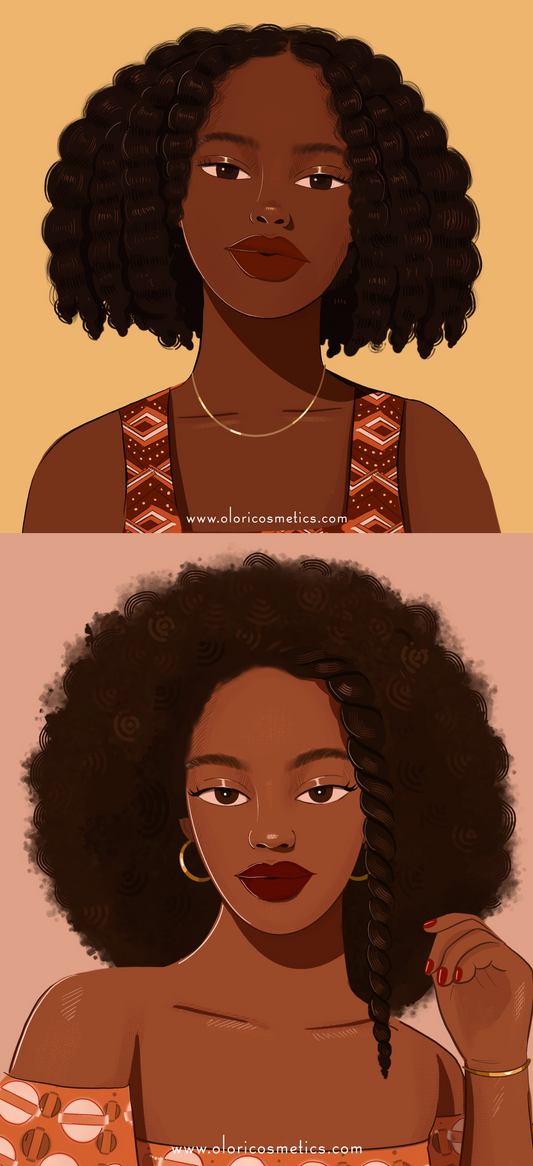
Natural hair is Afro-textured hair which is left chemically unaltered; in other words, hair which has not been relaxed or permed.
There’s a huge amount of diversity within the African diaspora, and in the same way, there’s a lot of diversity in the hair we have. Natural hair tends to fall between the 2C and 4C range, so it’s usually curly or coily (not wavy or straight). The coily-nature of natural hair strands means that each strand interweaves and takes up a lot more space compared to straight hair. As a result, natural hair appears far denser than any other hair type.
As porosity increases with chemical and physical damage to one’s hair, natural hair is often low porosity as it has incurred minimal chemical damage. Contrary to popular belief, natural hair can be super dense or not very dense at all.
Moisturizing your natural hair:
Moisturizing natural hair can be quite tasking. The low porosity tendency of natural hair means that it can be fairly challenging to get moisture to penetrate its strands, however, once it’s in, it’s there to stay. Use the LCO (Liquid Conditioner, Cream Conditioner, Oil) method to moisturize your hair; it’s very important that you use cream before oil for low porosity hair types, as the oil will prevent the cream from penetrating if you do it the other way round.
LOC Interlude: The LOC method is lauded as the most effective way of properly Moisturizing Afro-textured hair. It’s pretty simple, LOC stands for Liquid, Oil and Cream, and it can be used on hair of all curl patterns, including relaxed hair! The method goes as follows: hydrate your hair with a water-based product (Liquid), lock in that hydration by Moisturizing with an oil-based product (Oil) and seal the hair cuticle with a cream product (Cream).
LOC is the standard form, but there’s a couple of variations on this moisturisation method:
- LCO: This stands for Liquid, Cream and Oil. It’s the exact same steps as in the LOC method, just in a different order. This method is recommended for low porosity hair as the use of Cream before the Oil increases the amount of moisturisation being put into one’s hair before sealing the cuticle. Low porosity hair types are more difficult to get moisture into, but manage to keep it tightly locked in, so the LCO method puts the emphasis on hydration and moisturisation as opposed to sealing it in.
- LO: This is simply Liquid and Oil. It’s recommended for medium porosity hair, as this hair type absorbs and releases at an intermediate rate, so it doesn’t need too much moisturisation or too much locking in. Just a little of each is perfect.
The standard LOC method is highly recommended for high porosity hair as both the O and the C steps to the method contribute to barricading the moisture in.
Finally, on Moisturizing your natural hair, we recommend using a steam cap to deep condition and/or warming up your conditioners before you apply them.
Achieve this with the following OLORI products:
- For hydrating and Moisturizing: DamageBeGone 3-in-1 Multi Conditioner
- For sealing: DamageBeGone Happy Hair Butter
- For deep conditioning: DamageBeGone Deep Conditioner
Protective styling:
The best way to get moisture to stay locked into your hair is to use a protective style. Styling natural hair in braids and twists is a centuries-old practice, originating in African communities. Hairstyling was intricate and beautifully aesthetic, yet hugely practical as it allowed the original naturalistas to keep their hair moisturized for longer. We recommend keeping your hair in styles such as two (or three) strand twists or braids most of the time to keep your moisture locked in. Use a spray bottle filled with a mixture of leave-in conditioner, your choice of oil and water to moisturize your hair while still in its protective style.
Achieve this with the following OLORI products:
- For sealing: DamageBeGone Happy Hair Butter
- For your spray bottle: DamageBeGone 3-in-1 Multi Conditioner
Wash Day:
The infamous wash day. Wash day has a bad rep as a lot of naturals see it as an extremely tedious and exhausting downside to being natural. However, we at OLORI see it slightly differently. Think of it as a bi-monthly spa day for your hair…
Start by parting your hair into four sections. Liberally moisturize each section and detangle them as you go along, using your fingers, then a wide-toothed comb then a small toothed comb.
Once each section is detangled, go ahead and work your favorite shampoo into your hair, focusing it on your scalp and the hair closest to your head.
Once you feel your hair is sufficiently lathered, rinse this out.
Deep condition your hair; we recommend spending 20 to 40 minutes on this step.
Wash this out with a small amount of shampoo, then finally moisturize your wet strands using the LCO method and pop your hair into a simple protective style, such as big twists. You’re done!
Achieve this with the following OLORI products:
- For shampooing: DamageBeGone Conditioning Shampoo
- For detangling, hydrating and Moisturizing: DamageBeGone 3-in-1 Multi Conditioner
- For deep conditioning: DamageBeGone Deep Conditioner
- For sealing: DamageBeGone Happy Hair Butter
Hair State

The state of your hair can be split into two things, its physical state and its chemical state.
Physical state: This is affected by how it’s styled or physically manipulated; is your hair down or in a protective style? Is it blown out or straightened?
Chemical state: In other words, have you applied any chemicals to it? Have you relaxed or texturised your hair? Or have you recently used a protein/keratin treatment or henna? Or is your hair dyed or bleached?
All of these things contribute to the texture type of your hair, so it’s important to take them into consideration when figuring out what your hair needs.
Chemical treatments can affect your hair’s porosity, density and curl pattern:
Bleached - Increases porosity , Decreases density, Slightly loosens curl pattern
Dyed - Increases porosity, Minimal change, Slightly loosens curl pattern
Protein/keratin - Decreases porosity, Majorly increases density, Slightly loosens curl pattern (weighs your hair down)
Henna dyed/treated - Decreases porosity, Majorly increases density, Slightly loosens curl pattern (weighs your hair down)
Relaxed/texturised - Increased porosity, Decreases density, Dramatically loosens curl pattern
Whereas changes in the physical state of your hair affect its needs more than its attributes:
Loose hair - Needs more moisturisation, Needs more hydration, Scalp needs to be oiled regularly
Exposed protective style (i.e. styles with one’s own hair) - Retains more moisture than when left loose, but still needs regular moisturisation, Needs more hydration, Scalp needs to be oiled regularly
Unexposed protective style (e.g. braids with extensions, wigs, weaves) - Hair tends to retain more oil in these styles, so less moisturisation is needed, Needs more hydration, Scalp needs extra lubrication as extensions cause friction and dryness
Transitioning Hair
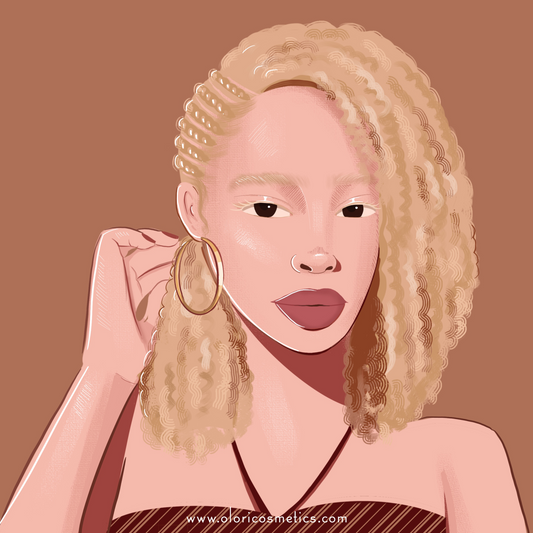
In order to “go natural” after having relaxed your hair, you have to get rid of your relaxed hair. You can either do this by:
- Cutting off all your relaxed hair (this is known as a Big Chop), or
- Leaving your hair alone and letting it transition slowly by trimming it regularly as your natural hair gradually grows out. Eventually, all the relaxed hair will have been trimmed off and you’ll be left with pretty long natural hair.
Thus, transitioning hair is Afro-textured hair which is in the middle of a transition from being relaxed to going natural. It’ll have gone a little while without being relaxed and, as a result, you’ll have ended up with hair which is relaxed near the ends, and natural near your scalp.
People who transition are usually people who don’t want to do a big chop – they want to go natural, but maintain the length and health of their hair as their natural hair gradually grows out. To keep your transitioning hair healthy, there’s a lot you’ll need to take into consideration.
You’ll be rocking a multi-textured head of hair with multiple porosities, multiple densities and very different curl patterns and you’ll have to cater to all of that at the same time. It’s gonna be a lot. But don’t worry ‘bout it, we’re here for you.
Caring for transitioning hair:
As your hair has multiple porosities, you’ll have to take some liberties when moisturizing it. We recommend moisturizing it as if it were low porosity/natural as this will ensure that all parts are thoroughly moisturized.
Although you want to keep all your hair as healthy as possible, it would make sense to lean a little in the natural hair care direction as that’s the hair you’ll end up with.
LOC Interlude: The LOC method is lauded as the most effective way of properly moisturizing Afro-textured hair. It’s pretty simple, LOC stands for Liquid, Oil and Cream, and it can be used on hair of all curl patterns, including relaxed hair!
The method goes as follows: hydrate your hair with a water-based product (Liquid), lock in that hydration by moisturizing with an oil-based product (Oil) and seal the hair cuticle with a cream product (Cream).
The LOC method is highly recommended for high porosity hair as both the O and the C steps to the method contribute to barricading the moisture in. LOC is the standard form, but there’s a couple of variations on this moisturisation method, depending on your hair’s porosity:
- LO: This is simply Liquid and Oil. It’s recommended for medium porosity hair, as this hair type absorbs and releases at an intermediate rate, so it doesn’t need too much moisturisation or too much locking in. Just a little of each is perfect.
- LCO: This stands for Liquid, Cream and Oil. It’s the exact same steps as in the LOC method, just in a different order. This method is recommended for low porosity hair as the use of Cream before the Oil increases the amount of moisturisation being put into one’s hair before sealing the cuticle. Low porosity hair types are more difficult to get moisture into, but manage to keep it tightly locked in, so the LCO method puts the emphasis on hydration and moisturisation as opposed to sealing it in.
We recommend following this order for your transitioning hair as it’ll give your hair as much moisturisation as possible. If you find that your relaxed/higher porosity strands are losing moisture easily, then double up on your oil step by adding extra oil to seal the moisture in on the ends of your hair.
Finally, on moisturizing your hair, we recommend using a steam cap to deep condition and/or warming up your conditioners before you apply them.
In addition to this, make sure you get regular trims to help you keep on track for meeting your target transitioning end date.
Achieve this with the following OLORI products:
- For hydrating and moisturizing: DamageBeGone 3-in-1 Multi Conditioner
- For sealing and oiling: DamageBeGone Happy Hair Butter
- For deep conditioning: DamageBeGone Deep Conditioner
Protective styling:
Putting your transitioning hair in protective styles will help you retain length and also maintain the uniform appearance of your hair. Style your hair in any low/medium-manipulation braided or twisted hairstyle, whilst being sure to take it down and detangle every couple of weeks to prevent knotting.
Use a spray bottle filled with a mixture of leave-in conditioner, your choice of oil and water to moisturize your hair while still in its protective style.
Achieve this with the following OLORI products:
- For sealing: DamageBeGone Happy Hair Butter
- For your spray bottle: DamageBeGone 3-in-1 Multi Conditioner
Wash Day:
Start by parting your hair into four sections. Heavily moisturize each section and detangle them as you go along, using your fingers, then a wide-toothed comb then a small toothed comb. It’s important to take a lot of care when detangling transitioning hair, as your relaxed ends can be prone to intertwining.
Once each section is detangled, go ahead and work your favorite shampoo into your hair, focusing it on your scalp and the hair closest to your head. Once you feel your hair is sufficiently lathered, rinse this out.
Deep condition your hair; we recommend spending 20 to 40 minutes on this step and repeating this every two weeks. Wash this out with a small amount of shampoo, then finally moisturize your wet strands using the LOC method and pop your hair into a simple style, such as a bun or big twists. You’re done!
Achieve this with the following OLORI products:
- For shampooing: DamageBeGone Conditioning Shampoo
- For detangling, hydrating and moisturizing: DamageBeGone 3-in-1 Multi Conditioner
- For deep conditioning: DamageBeGone Deep Conditioner
- For sealing: DamageBeGone Happy Hair Butter
Kiddie Hair
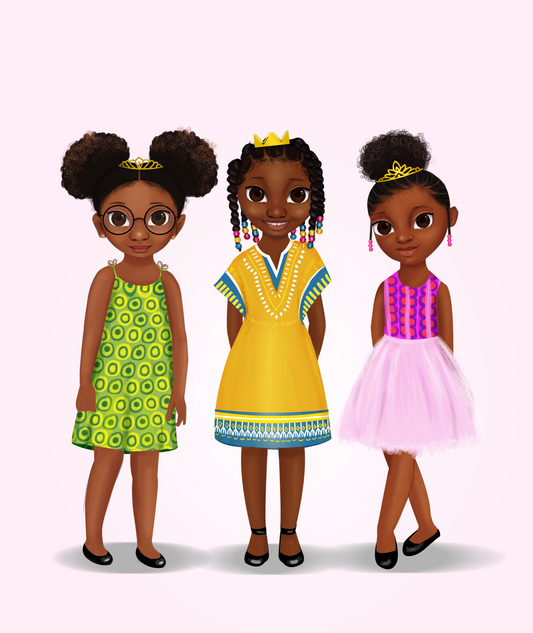
When it comes to kiddie hair, there’s a lot of similarities with adult hair. Kids’ hair can be long or short, dyed or curled, thick or thin, low porosity or high porosity. Their hair is just as diverse as yours!
However, there’s a major characteristic which is shared between all children between the ages of 0 and 10. When you look at a newborn baby’s hair, have you noticed that it’s a lot softer and thinner than adult hair? That’s because their strands are pretty different from ours.
Babies are born with vellus hair: strands which are thin and soft as a result of not being connected to the sebaceous gland, the gland that produces sebum which coats and lubricates the hair. Vellus strands are a lot more fragile than our normal, adult, terminal hair, so it’s especially important to make sure you’re taking care to gently oil and lubricate your child’s hair to strengthen it.
Vellus hair gradually sheds as a child ages, usually between the ages of 4 and 8, after which your child will have mostly terminal strands of hair.
In Africa, we have a common practice of shaving a child’s entire head of hair when they’re between the ages of 1 and 3. We do this with the aim of speeding up the process of vellus-shedding, so that when the hair grows back, the child is left with only terminal strands. Though this practice is more of an old wives’ tale than actual science, it’s rooted in an understanding that babies’ hair is more delicate than adult hair.
With that in mind, no matter what else you do, make sure you show your child’s hair a lot of love. Keep it moisturized, hydrated and lubricated with light conditioners and oils, depending on
their age…
Ages 0-3
Between the ages of 0 and 3, you’ll need to be very particular about what products you use on your child’s hair. At this age, you can’t use the same products on your child as you’d use on yourself. Keep it simple; we recommend simply using water and a light oil such as virgin olive oil.
Finally, it’s important to take good care of your child’s scalp. Younger scalps need more lubrication, so make sure you’re oiling and moisturizing their scalp liberally. Kiddie hair can’t take as much manipulation as adult hair, due to their more sensitive scalps, so we recommend using looser protective styles on your kiddies, or avoiding styling their hair altogether if it’s short enough to get away with doing so.
Achieve this with the following OLORI products:
Age 2+: DamageBeGone Happy Hair Butter
Ages 4-8
This is the age bracket where your child’s vellus hair will begin to shed. At this point, their hair will become a lot more thick and robust, so it’ll start to require slightly more thorough moisturisation. You can begin to use leave-in conditioners on your child’s hair; we recommend following the LOC method to moisturize their hair (learn more about this in our Porosity guide).
You can also begin to use non-baby shampoo on their hair, but be extra careful to keep this out of their eyes.
Achieve this with the following OLORI products:
- Age 2+: DamageBeGone Happy Hair Butter
- Age 4+: DamageBeGone 3-in-1 Multi Conditioner
- Age 6+: DamageBeGone Conditioning Shampoo
Ages 9-13
At this point, you can begin to treat your child’s hair pretty much the same way you treat yours. We recommend still using a light touch with their hair; avoid putting their hair in high-manipulation styles and be careful when shampooing. See our Natural Hair guide (hyperlink) for more information on how to take care of your child’s natural hair.

